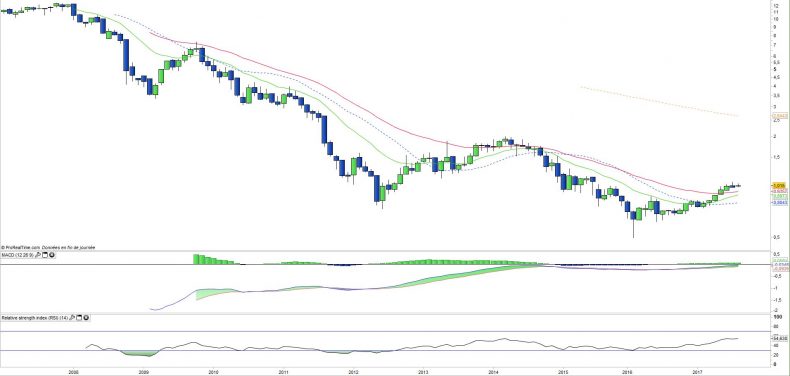Lyxor FTSE ATHEX Large Cap (GRE) - 22/08/2017
Short term strategy : Positive (50%) / Trend -
Long ter strategy : Positive (85%) / Trend +
Characteristics of the ETF
The ETF GRE (Lyxor) replicates the FTSE ATHEX index, which is composed of 26 companies.
It is therefore rather narrow compared to other national indices but is rather diversified with 31% for the financial sector which brings together the main banks in the country (Alpha Bank, National Bank of Greece, Eurobank ergasias, Piraeus Bank), the consumer goods sector accounts for 22% (mainly the Coca-Cola subsidiary), about 10% for telecommunications (Hellenic Telecoms) while Cement, Energy, Materials made up the bulk of the complement, also noting the presence of a gaming / betting company: OPAP, which accounts for nearly 9% of the capitalization.
The performance of this ETF since the beginning of the year is already 25%, after 3 years of decline, which is encouraging and corresponds to the gradual rebound of the Greek economy under a background of European embellishment.
At cost level this ETF is rather above the average at 0.45% and it works by indirect replication (Swaps). Assets Under Management : 207 M€.
The Greek economy is at about the same level as Portugal, with a GDP of around € 200 billion. The worst seems behind for Greece, which returned to growth in 2016 at + 0.3% and the European Commission expects + 2.1% in 2017 and + 2.5% in 2018. Thanks to the economic diversification carried out by the Country, industry has replaced agriculture as a second source of income after services, accounting for 15.7% of GDP and employing 15% of the labor force, although its share was higher (20%) before the crisis in 2007. The main sectors are electronics, transportation equipment, clothing manufacturing and construction. Greece has the largest maritime fleet in the world and the tertiary sector accounts for 80% of GDP and employs 71% of the labor force, while tourism alone contributes to 11% of GDP.
Greece has an open economy, with trade accounting for 64% of GDP, Greece's main trading partners are the European Union (in particular Italy and Germany), Turkey and Russia. In 2016, the budget deficit was reduced by a reform of VAT and a better tax collection, nevertheless, bank deposits remained low and control of capital continued in 2016, consequently the transactions between greek companies and foreigners remain constrained. Capital controls have also affected exports related to shipping. If progress continues, Greece could benefit from a significant debt cut in 2018, after the German elections. This recovery is attributable to a renewed confidence between the government and the international financial community.
Greece has just succeeded in returning to the markets by placing a five-year bond for the first time in three years, the Greek State borrowed € 3 billion at a rate of 4.625%, lower than the last bond issue, in 2014, which was 4.95%. This is encouraging and shows the progress made. Economic activity seems to be spreading in 2017 thanks to the banking sector, which continues to stabilize, and a more favorable European context. The rating agencies raise their ratings one after the other (Fitch has recently raised the rating of Greece to B-). After a lost decade, Greece seems able to gradually regain its financial and fiscal autonomy.
Monthly data
The analysis of monthly charts shows that GRE is again in a bullish trend. However, this upward trend is not yet complete from a technical point of view. A double confirmation should come from the crossoverof the 13 & 26 monthly EMA, on the one hand, and the crossing of the line of zero from the MACD.
This confirmation is expected to take place in the coming months, likely leading to an acceleration of the trend.
Weekly data
Analysis of the weekly charts shows a mid-term bullish technical configuration. However, a period of hesitation has been perceptible in recent weeks, which is linked to the international context and the correction of European equity markets. The MACD has turned down, but prices are stable and well above average.
This flat correction is rather to be regarded as a sign of resilience of the Greek index.
ETF Objective
GRE is a UCITS compliant ETF that aims to track the benchmark index FTSE ATHEX LARGE CAP Net Total Return (26 companies).
Characteristics
| Inception date | 05/01/2007 |
| Expense ratio | 0,45% |
| Issuer | Lyxor |
| Benchmark | FTSE ATHEX Large Cap |
| Code / Ticker | GRE |
| ISIN | FR0010405431 |
| UCITS | Yes |
| EU-SD status | Out of scope |
| Currency | € |
| Exchange | Euronext Paris |
| Assets Under Management | 207 M€ |
| Replication Method | Indirect (swap) |
| PEA (France) | Yes |
| SRD (France) | Yes |
| Dividend | Capitalisation |
| Currency risk | Yes |
| Number of holdings | 26 |
| Risk | 4/5 |
Country Breakdown
| Greece | 78% |
| Switzerland | 21% |
| Belgium | 1% |
Sector Breakdown
| Financials | 31% |
| Consumer staples | 22% |
| Consumer discretionary | 17% |
| Telecom services | 10% |
| Industrials | 7% |
| Energy | 6% |
| Materials | 4% |
| Others | 4% |
Top Ten Holdings
| Coca Cola HBC | 21% |
| Alpha Bank | 11% |
| Hellenic Telecom | 10% |
| OPAP | 8% |
| National Bank of Greece | 7% |
| Eurobank Ergasias | 6% |
| Jumbo SA | 5% |
| Piraeus Bank | 5% |
| Motor Oil | 4% |
| Titan Cement | 4% |


